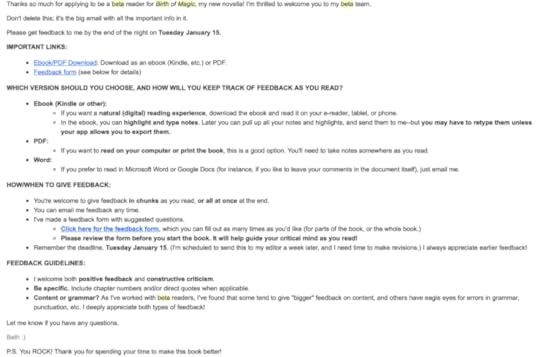Working with Early Readers, Part 2: BETA READERS
This is Part 2 of a series for indie authors.
To read the series intro, click here.
To read Part 1: ALPHA READERS, click here.
How many beta readers should you have? Some people say one or two; others say as many as you can get!
I used to be in the latter camp, but when I had over twenty beta readers for one book, I did find it a bit overwhelming. I think twenty is probably my max, but you’ll have to figure out what works for you.
I got a lot of inspiration for my beta reading system from one of my favorite authors, Michael J. Sullivan, and his wife Robin. Robin runs an amazing beta team for Michael. I’m not on that team, but in Michael’s newsletter, they’ve been kind enough to share how their beta reading process works.
 Image source: pixabay.com
Image source: pixabay.comLet’s jump in!
Here’s are two keys to a successful beta reading round:
Provide betas with a manuscript that, while imperfect, is already in good reading condition. Typos, grammar issues, and plot issues will exist, but they shouldn’t be so egregious that your beta readers don’t even want to finish the book!Communicate, communicate, communicate. Then communicate some more. People are busy. You’ve got to help them remember their commitment to beta read, and give them enough guidance to do so successfully!
Where can I find betas?
As with alpha readers, I started with people I knew! Sure, they weren’t all fans of the genre, but they were people willing to read my work. You gotta start somewhere!
I started a newsletter (mostly friends and family from Facebook) and asked my subscribers to apply as beta readers.I asked on my personal Facebook page.I started a Facebook author page (again, mostly friends and family) and asked there.Once I’d been through this process on one book, I sent special requests to former betas to repeat their roles.I’ve also invited people on Twitter to apply as beta readers.When I request beta readers, I try to be very specific about what I’m asking. Check out this newsletter to see what I mean.
How my beta-reading process works:
Prospective beta readers fill out a beta reader application. Here’s the one I used for Birth of Magic.Just filling out the application shows a certain level of commitment! So in the past, I’ve accepted everyone who filled out the application. However, from now on, I’ll be more selective if I get more than 20 applications.Even if I communicate very well with beta readers, I only get feedback from about 2/3 to 3/4 of them.Once I’ve chosen my beta team and the book is ready, I send each of them an intro e-mail. I’m very clear on their deadlines (usually four weeks for a novel and at least two weeks for a novella) and what I’m looking for. Here’s my intro email for Birth of Magic:

As you can see above, I give beta readers a feedback form. It’s optional, but most of them use it, and it really helps me get useful feedback! Check out my Birth of Magic beta feedback form.I try to email my beta readers about once a week through the process, reminding them of the deadline. I always do this as a response to the original email so that they can look back at all the info I shared originally. I respond to every person who gives feedback, giving them my heartfelt gratitude…even if the feedback was overall negative. Sometimes (definitely not always), I respond to individual suggestions, letting them know the direction I’m going, so they feel like I’m taking the suggestions seriously. I incorporate beta feedback in my next big revision round.
How I decide which feedback to incorporate:
First, I go with my gut. Does the feedback feel right? If it does, I change it.If more than one person has the same feedback, I might change it, even if it didn’t initially strike me as necessaryAnd of course I change grammar errors, typos, etc. that my betas find!
Once you’ve made revisions based on beta feedback, it’s time for final polishing. That might involve a professional editor and/or proofreader, or an additional read-through by you, the author, or even another beta round…whatever you need to get your book ready for ARC reviewers.
Click here for Part 3 of this series: ARC reviewers.
Author Resources on my website are 100% free. But if you’d like to buy me a coffee to thank me, click the button!



